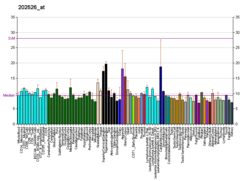| Молекулярна функція | • protein homodimerization activity
• protein heterodimerization activity
• RNA polymerase II transcription regulatory region sequence-specific DNA binding
• зв'язування з іоном металу
• DNA binding
• GO:0001131, GO:0001151, GO:0001130, GO:0001204 DNA-binding transcription factor activity
• sequence-specific DNA binding
• GO:0001158 cis-regulatory region sequence-specific DNA binding
• GO:0001077, GO:0001212, GO:0001213, GO:0001211, GO:0001205 DNA-binding transcription activator activity, RNA polymerase II-specific
• I-SMAD binding
• collagen binding
• GO:0001948, GO:0016582 protein binding
• GO:0000980 RNA polymerase II cis-regulatory region sequence-specific DNA binding
• R-SMAD binding
• identical protein binding
• sulfate binding
• GO:0001200, GO:0001133, GO:0001201 DNA-binding transcription factor activity, RNA polymerase II-specific
• GO:0001104 transcription coregulator activity
• molecular function regulator
• chromatin binding
|
|---|
| Біологічний процес | • negative regulation of cell population proliferation
• Сперматогенез
• positive regulation of pathway-restricted SMAD protein phosphorylation
• positive regulation of luteinizing hormone secretion
• regulation of cell population proliferation
• cardiac septum development
• negative regulation of cell death
• regulation of hair follicle development
• cellular response to BMP stimulus
• epithelial to mesenchymal transition involved in endocardial cushion formation
• brainstem development
• проліферація
• regulation of binding
• SMAD protein complex assembly
• metanephric mesenchyme morphogenesis
• positive regulation of epithelial to mesenchymal transition
• GO:0007329 positive regulation of transcription from RNA polymerase II promoter involved in cellular response to chemical stimulus
• GO:0044324, GO:0003256, GO:1901213, GO:0046019, GO:0046020, GO:1900094, GO:0061216, GO:0060994, GO:1902064, GO:0003258, GO:0072212 regulation of transcription by RNA polymerase II
• branching involved in ureteric bud morphogenesis
• GO:0009373 regulation of transcription, DNA-templated
• embryonic digit morphogenesis
• uterus development
• axon guidance
• somatic stem cell population maintenance
• гаструляція
• positive regulation of histone H3-K4 methylation
• GO:0045996 negative regulation of transcription, DNA-templated
• response to transforming growth factor beta
• endothelial cell activation
• positive regulation of transforming growth factor beta receptor signaling pathway
• single fertilization
• transforming growth factor beta receptor signaling pathway
• anterior/posterior pattern specification
• in utero embryonic development
• positive regulation of cell proliferation involved in heart valve morphogenesis
• atrioventricular valve formation
• GO:0007243 intracellular signal transduction
• developmental growth
• endoderm development
• cellular iron ion homeostasis
• розвиток нирки
• GO:0007364, GO:0007361, GO:0007358 formation of anatomical boundary
• positive regulation of histone H3-K9 acetylation
• regulation of transforming growth factor beta2 production
• interleukin-6-mediated signaling pathway
• GO:1901227 negative regulation of transcription by RNA polymerase II
• male gonad development
• ovarian follicle development
• endocardial cell differentiation
• nephrogenic mesenchyme morphogenesis
• gastrulation with mouth forming second
• female gonad development
• SMAD protein signal transduction
• response to hypoxia
• atrioventricular canal development
• mesoderm development
• negative regulation of cell growth
• GO:0060469, GO:0009371 positive regulation of transcription, DNA-templated
• BMP signaling pathway
• tissue morphogenesis
• GO:0003257, GO:0010735, GO:1901228, GO:1900622, GO:1904488 positive regulation of transcription by RNA polymerase II
• positive regulation of SMAD protein signal transduction
• somite rostral/caudal axis specification
• sebaceous gland development
• positive regulation of follicle-stimulating hormone secretion
• positive regulation of BMP signaling pathway
• neural crest cell differentiation
• seminiferous tubule development
• female gonad morphogenesis
• regulation of transforming growth factor beta receptor signaling pathway
• neuron fate commitment
• transcription, DNA-templated
• outflow tract septum morphogenesis
• left ventricular cardiac muscle tissue morphogenesis
• negative regulation of cardiac muscle hypertrophy
• protein deubiquitination
• ventricular septum morphogenesis
• negative regulation of ERK1 and ERK2 cascade
• negative regulation of cardiac myofibril assembly
• protein homotrimerization
• pri-miRNA transcription by RNA polymerase II
• secondary palate development
• anatomical structure morphogenesis
• диференціація клітин
• mesendoderm development
|
|---|












